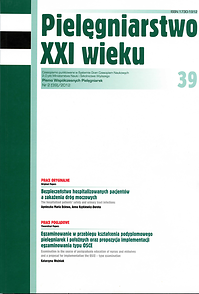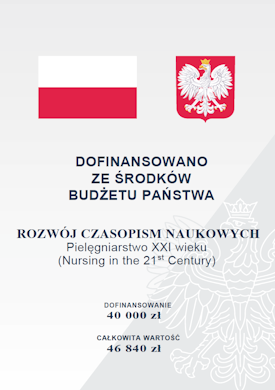Bezpieczeństwo hospitalizowanych pacjentów a zakażenia dróg moczowych
Słowa kluczowe:
cewnikowanie dróg moczowych, zakażenia szpitalne, bezpieczeństwo pacjentaAbstrakt
BEZPIECZEŃSTWO HOSPITALIZOWANYCH PACJENTÓW A ZAKAŻENIA DRÓG MOCZOWYCH
Wprowadzenie. Bezpieczeństwo hospitalizowanych pacjentów jest zdeterminowane wieloma czynnikami. Wśród nich jednym z najważniejszych jest zapobieganie zakażeniom szpitalnym, m. in. zakażeniom dróg moczowych. Zakażenia układu moczowego należą do jednych z najczęściej występujących zakażeń szpitalnych, szacowanych na około 30-40%.
Cel pracy. Celem pracy była ocena częstości występowania zakażeń szpitalnych związanych obecnością cewnika w drogach moczowych u hospitalizowanych pacjentów.
Materiał i metody. Badania prowadzono w ciągu trzech miesięcy 2008r. w SP ZOZ w Kraśniku w dwóch oddziałach internistycznych, oddziale intensywnej terapii i oddziale rehabilitacyjnym. Narzędzia do badań stanowiły: standaryzowany kwestionariusz wywiadu „Kryteria oceny jakości opieki pielęgniarskiej w profilaktyce zakażeń szpitalnych”, zmodyfikowany przez autora niniejszej pracy oraz „Karta obserwacji pacjenta cewnikowanego”. Ponadto korzystano z dokumentacji medycznej pacjenta oraz dokumentacji zakażeń szpitalnych.
Wyniki. W analizowanym okresie zarejestrowano 41 przypadków zakażeń układu moczowego (ZUM) w całym szpitalu, a na badanych oddziałach 15. ZUM w tym czasie stanowiły 23,6% ogółu zakażeń w szpitalu i 36,6% na czterech badanych oddziałach.
Wnioski. Największa liczba szpitalnych zakażeń układu moczowego dotyczy pacjentów obarczonych dużym ryzykiem wynikającym z występującej jednostki chorobowej, urazów lub dysfunkcji wielu układów, natężenia realizowanych procedur medycznych. Elementem profilaktyki ZUM jest ograniczenie cewnikowania pęcherza moczowego tylko do bezwzględnych wskazań.
Bibliografia
1. Rahn DD. Urinary tract infections: contemporary management. Urol. Nurs. 2008;28:333-41.
2. Kupilas A. Zakażenia układu moczowego. Przeg. Urol. 2006; 38: 42-9.
3. Lenartowicz H. Zarządzanie jakością w pielęgniarstwie. Warszawa: Centrum Edukacji Medycznej; 1998.
4. Duława J, Ramos P. Problemy zakażeń układu moczowego u hospitalizowanych pacjentów. Zakażenia. 2006;6(5):26-29.
5. Djordjević Z, Ilić M. Urinary tract nosocomial infections at the Clinical Centre in Kragujevac. Srp Arh Celok Lek. 140(3-4):184-90.
6. Saint S, Elmore JG, Sullivan SD et al. The efficiacy of silver allom-coated urinary catheters in preventing urinary tract infection: a meta analysis. Am. J. Med. 1998; 105: 236-41.
7. Bartoszewicz M, Sobania M. Procedury postępowania pielęgniarskiego zapobiegające odcewnikowym zakażeniom dróg moczowych u hospitalizowanych pacjentów. Materiały Konferencyjne IX Zjazdu Polskiego Stowarzyszenia Pielęgniarek Epidemiologicznych Wisła 24-26 kwietnia 2006. Pielęgniarka Epidemiologiczna Informator. 2006; 2(25): 14.
8. Kanj S, Kanafani Z, Sidani N et all. International nosocomial infection control consortium findings of device-associated infections rate in an intensive care unit of a lebanese university hospital. J. Glob. Infect. Dis. 2012;4(1):15-21.
9. Bernard MS, Hunter KF, Moore KN. A review of strategies to decrease the duration of indwelling urethral catheters and potentially reduce the incidence of catheter-associated urinary tract infections. Urol Nurs. 2012; 32(1): 29-37.
10. Fleischer M, Bober – Gheek J. Podstawy pielęgniarstwa epidemiologicznego. Wrocław: Wydawnictwo Medyczne Urban Partner; 2006.
11. Weber DJ, Sickbert-Bennett EE, Gould CV et all. Incidence of catheter-associated and non-catheter-associated urinary tract infections in a healthcare system. Infect Control Hosp Epidemiol. 2011; 32(8): 822-3.
12. Frimodt-Moller N, Cameliussen L. Test in vitro różnych zestawów do godzinowej zbiórki moczu na eksperymentalnym modelu drenażu pęcherza: skuteczność zapobiegania wstępującej kontaminacji zależy od konstrukcji zestawu. Zakażenia. 2007; 3: 111-116.
13. Platt R, Polk BF, Murdoch B. Risk factors for nosocomial urinary tract infection. Am. J. of Epidem. 1986; 14: 977.
14. Blenkham JJ. Prevention of bacteriuria during urinary catherisation of patients in an intensive care unit: evaluation of the Ureofix 500 closed drainage system. J. of Hosp. Infec. 1985; 6(2): 187-91.
15. Vittori M, D'Addessi A, Sasso F, “et all”. Microbiological follow-up of nosocomial infections in a single urological center. Urologia. 2012; 26:304-10.
16. Tambyah PA, Oon J. Catheter-associated urinary tract infection. Curr Opin Infect Dis. 2012; 25(4): 365-70.
17. Ishihara K. The urinary tract infection. Intern. J. Dent. Hyg. 2003; 5: 69-74.
18. Rosenthal VD, Todi SK, Alvarez-Moreno C et all. Impact of a multidimensional infection control strategy on catheter-associated urinary tract infection rates in the adult intensive care units of 15 developing countries: findings of the International Nosocomial Infection Control Consortium (INICC). Infection. 2012; 19: 376-84.
19. Rosenthal VD, Bijie H, Maki DG et all. International Nosocomial Infection Control Consortium (INICC) report, data summary of 36 countries, for 2004-2009. Am J Infect Control. 2012;40(5):396-407.
20. King C, Garcia Alvarez L, Holmes A et all. Risk factors for healthcare-associated urinary tract infection and their applications in surveillance using hospital administrative data: a systematic review. J Hosp Infect. 2012; 15: 156-60.
Pobrania
Opublikowane
Numer
Dział
Licencja
Prawa autorskie (c) 2012 Agnieszka Maria Dziewa, Anna Ksykiewicz-Dorota (Autor)

Utwór dostępny jest na licencji Creative Commons Uznanie autorstwa 4.0 Międzynarodowe.




